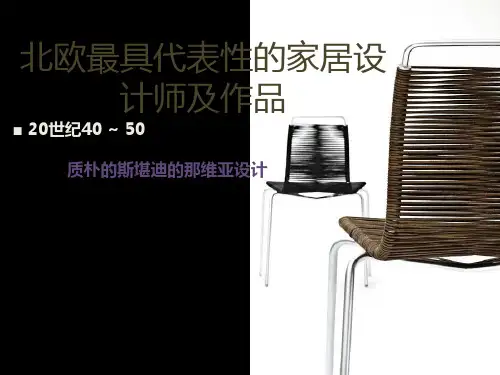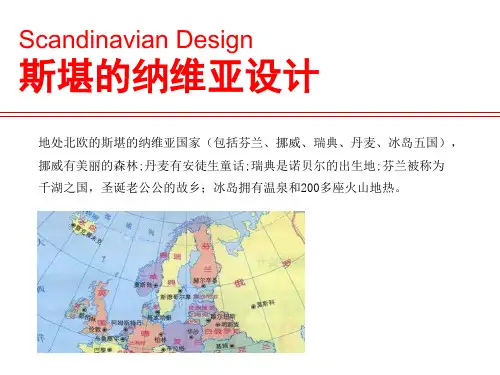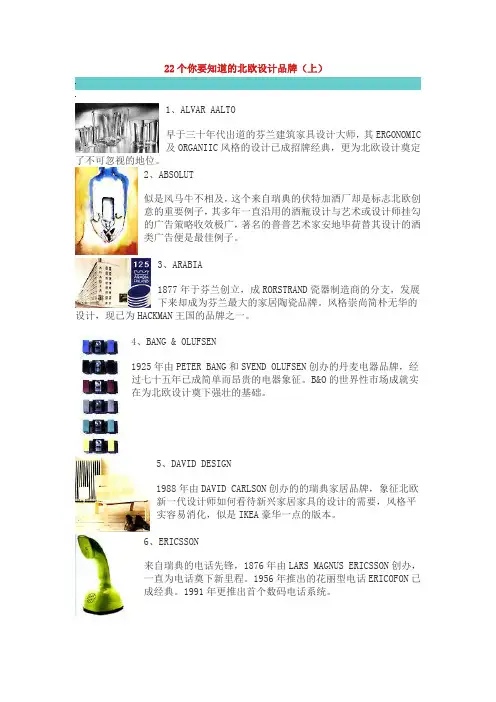北欧家具设计
- 格式:pptx
- 大小:4.57 MB
- 文档页数:1





浅谈北欧风格家居设计的发展之路北欧风格家居设计源自北欧国家,一直以来以其简约、舒适、自然的特点备受世界各地消费者的青睐。
随着全球化的发展和人们对舒适家居生活的追求,北欧风格家居设计在世界范围内越来越受到关注和喜爱。
本文将从北欧风格家居设计的起源、发展历程和特点等方面,来浅谈北欧风格家居设计的发展之路。
一、北欧风格家居设计的起源北欧风格家居设计起源于北欧国家,包括丹麦、瑞典、挪威、芬兰和冰岛等国家。
这些国家地处寒带,气候寒冷,长期处于低温多雨的气候环境中,因此北欧地区的居民在设计家居时更加注重舒适性和实用性。
受地理环境的影响,北欧地区的家居设计充满了朴素、自然和简约的特点。
比如丹麦的家具设计追求简洁、实用,瑞典的家居设计善于利用光线和空间,挪威的家居设计注重与自然的融合,芬兰的设计追求木质材料的运用等等。
这些共同的特点构成了北欧风格家居设计的基本特征。
北欧风格家居设计在20世纪上半叶开始逐渐走向世界。
以丹麦为例,20世纪初,丹麦的家具制造业就迅速崛起,其设计师们一直试图打破传统的家具设计,推崇简约、实用和美观的风格。
随着工艺技术的不断改进和时代的变迁,北欧风格家居设计逐渐深入人心,并在国际上崭露头角。
20世纪50年代,北欧风格家居设计开始迅速走向世界舞台。
瑞典家居品牌宜家(IKEA)成立,以其简约、实用的家居设计风格受到全球消费者的追捧。
宜家的成功也为北欧风格家居设计的国际化奠定了基础。
到了21世纪,随着全球经济一体化的不断深入,北欧风格家居设计在世界范围内得到了更加广泛的推广和发展。
不仅在家居产品上,北欧风格的设计理念也渗透到了建筑、室内装饰、家居用品等方方面面,成为世界范围内备受瞩目的设计风格之一。
1. 简约:北欧风格的家居设计追求简单、纯粹的美感,摒弃了过多的修饰和装饰。
家具和装饰品通常以直线、曲线和简单的图案为主,营造出简约而不失优雅的氛围。
2. 实用:北欧人民注重实用性,他们的家居设计体现了极高的功能性和实用性。

丹麦设计大师潘顿(Verner Panton)Verner Panton(1926~1998)潘顿是丹麦著名工业设计师,1947-1951在丹麦皇家艺术学院学习,曾在雅各布森(Arne Jacobsen)的事务所工作过,后定居瑞士巴塞尔。
他打破北欧传统工艺的束缚,运用鲜艳的色彩和崭新的素材,开发出充满想象力的家俱和灯饰。
从50年代末起,他就开始了对玻璃纤维增强塑料和化纤等新材料的试验研究。
60年代,他与美国米勒公司合作进行整体成型玻璃纤维增强塑料椅的研制工作,于1968年定型。
这种椅可一次模压成型,具有强烈的雕塑感,色彩也十分艳丽,至今仍享有盛誉,被世界许多博物馆收藏。
潘顿还长于利用新材料来设计灯具,如1970年设计的潘特拉灯具,1975年用有机玻璃设计的VP球形吊灯。
同时,他还是一位色彩大师,他发展的所谓平行色彩理论,即通过几何图案,将色谱中相互靠近的颜色融为一体,为他创造性地利用新材料中丰富的色彩打下了基础。
Verner Panton于1967年设计的Panton Chair,简洁利落的线条,一体成型、造型完美,让人眼睛为之一亮,至今仍深受人们的青睐,常可看到它的身影被运用在不同的空间。
芬兰设计大师:艾洛·阿尼奥(Eero Aarnio)Eero AarnioEero Aarnio 1932 年生于芬兰,于1954 年至1957 年求学赫尔辛基的Institute of Industrial Arts,并在1962 年成立个人工作室,从事室内设计与工业设计。
他的许多作品享誉全球的国际知名度,并获得许多工业设计奖项。
例如,他在1963 年设计了著名的Ball Chair,这是张以玻璃纤维制成的球形椅子;很快地这张椅子被大量地制造生产。
而玻璃纤维,成为Aarnio 设计时最喜欢使用的素材。
其它代表作品还包括有糖果椅(Pastil Chair)、蕃茄椅(Tomoto Chair)和极富未来感的泡泡椅(Bubble Chair),是波普风格爱好者不可不知的设计大师之一。



58随着经济全球化的发展,各国之间的往来日益频繁,这不仅体现在经济发展上,还体现在世界各地的民族文化、历史文化等方面的交流上。
和谐统一已成为世界发展的主旋律,“只有民族的才有可能成为世界的”这个理念逐渐渗透到各行各业。
对于家具设计来说,只有具有本民族的文化特色,才能在日益发展变化的国际舞台上站稳脚跟,换句话说,家具设计应体现“和而不同”的思想。
我国传统家具在世界家具体系中享有盛誉,尤其是明式家具,是中华民族传统文化中的一朵奇葩。
但是,我国现代家具设计的发展还远落后于一些发达国家,对现代中式家具设计理论的研究还存在很多不足。
这不仅需要家具设计者挖掘本民族的文化精髓,还要借鉴其他国家的优秀设计经验,以弥补我们在家具设计中的空缺和不足。
一、现代中式家具设计现状分析中国现代家具设计思想存在于中国社会文化、经济文化、审美文化等各种文化体系中。
传统文化对现在和将来文化发展的影响永远不会停止,因此,传统家具对现代家具设计的影响是持久的。
在看待传统与现代的设计思想上,究竟是对传统充分肯定还是有选择地继承和发扬,已经成为业内人士广泛讨论的焦点。
意大利设计师Ettore Sottsass认为:“保护传统并非是单纯地重复传统”。
对设计文化的思考不应该是简单地进行一场文艺复兴运动,而应该是重新认识本民族的思想文化,重新认识人与自然之间的关系。
所以,对传统家具,我们应该认真研究,在取其精华去其糟粕的基础上进行创新设计[1]。
现代中式家具与北欧现代家具设计的对比分析文/刘宏利 朱毅“现代中式家具”这个名词在家具业里众所周知,但是,目前对现代中式家具设计的探索式理论研究和设计实践还未达到一个令人满意的程度,“拷贝”、“抄袭”现象仍普遍存在。
大多数专家学者一致认为,大力发展有中国特色的原创家具设计是我国家具业近期的主要任务之一。
真正有生命力的家具设计必然建立在民族传统文化的基础之上,“只有民族的才有可能成为世界的”[2]。
现代中式家具,应该以我国优秀传统家具设计为蓝本,巧妙地将中华民族的传统文化与时代发展的潮流相结合,并与现代人们的居住环境、生活习惯、工作方式等因素相协调。


22个你要知道的北欧设计品牌(上)1、ALVAR AALTO早于三十年代出道的芬兰建筑家具设计大师,其ERGONOMIC及ORGANIIC风格的设计已成招牌经典,更为北欧设计奠定了不可忽视的地位。
2、ABSOLUT似是风马牛不相及,这个来自瑞典的伏特加酒厂却是标志北欧创意的重要例子,其多年一直沿用的酒瓶设计与艺术或设计师挂勾的广告策略收效极广,著名的普普艺术家安地毕荷替其设计的酒类广告便是最佳例子。
3、ARABIA1877年于芬兰创立,成RORSTRAND瓷器制造商的分支,发展下来却成为芬兰最大的家居陶瓷品牌。
风格崇尚简朴无华的设计,现已为HACKMAN王国的品牌之一。
4、BANG & OLUFSEN1925年由PETER BANG和SVEND OLUFSEN创办的丹麦电器品牌,经过七十五年已成简单而昂贵的电器象征。
B&O的世界性市场成就实在为北欧设计奠下强壮的基础。
5、DAVID DESIGN1988年由DAVID CARLSON创办的的瑞典家居品牌,象征北欧新一代设计师如何看待新兴家居家具的设计的需要,风格平实容易消化,似是IKEA豪华一点的版本。
6、ERICSSON来自瑞典的电话先锋,1876年由LARS MAGNUS ERICSSON创办,一直为电话奠下新里程。
1956年推出的花丽型电话ERICOFON已成经典。
1991年更推出首个数码电话系统。
7、HACKMAN芬兰家居用品之国,1790年由JOHANF.HACKMAN创办,发展至今已成为拥有ARABIA及ⅡTTALA的家居大哥,本身以生产厨房用具为主。
8、FRITZ HANSEN1872年于丹麦哥本哈根由FRITZ HANSEN成立的家具制造商,百年后已成为网罗最多北欧建筑大师的家具设计的品牌,由ARNE JACOBSON到POUL KJAERHOLM到VERNER PANTON 再到PIET HEIN等。
9、HASSELBLAD瑞典哈苏已成摄影发烧友的经典,由VICTOR HASSELBLAD于1948年创办,成绩有目共睹,是首个特地聘请设计师设计机身的相机品牌。
北欧轻奢床头柜工艺及材料说明
北欧风格家具是北欧风格家居的主要元素,它的特点是简洁,造型别致,做工精细,喜好纯色。
北欧风格家具借鉴了包豪斯设计风格,并融入斯堪迪纳维亚地区的特色,形成了以自然简约为主的独特风格。
北欧轻奢床头柜工艺:关键词就是,简约、人性。
是指二十世纪初,现代工业在北欧确立后,本土传统的手工艺与工业化结合起来,并受到欧洲大陆现代主义设计运动的影响,掀起了一场设计思潮的革命,将艺术与实用结合起来形成了一种更舒适更富有人情味的设计风格。
它改变了纯北欧风格过于理性和刻板的形象,融入了现代文化理念,加入了新材质的运用,更加符合国际化社会的需求。
材料说明:一、吸塑板:吸塑板一般基本材都是为密度板,它具有耐划耐热房屋防掉色等等作用,而且维护也很简单,是一种比较成熟的床头柜材料。
二、实木板:实木制作的床头柜风格比较偏为古典性,价位也比较高,他的门框为实木,一般都是在实木表面做造型,然后再喷漆,从而保持原生色的特殊视觉效果。
北欧风格装修特点及设计说明1.简约的设计:北欧风格注重简洁和实用性,拒绝过多的装饰和复杂的图案。
家具和摆设都具有简单的线条和几何形状。
整个空间呈现出干净、整洁和有序的感觉。
2.自然的材料:北欧风格的装修使用自然的材料,如木材、石材和纺织品。
木地板是常见的地板选择,为房间增添了温暖和舒适感。
家具通常采用原木或白色漆面的木材制作,以保持自然和朴实的风格。
3.淡雅的色彩:北欧风格的色彩通常以白色为主导,搭配灰色、蓝色和木色等中性色调。
这些淡雅的色彩使得空间看起来更加明亮、通透和宽敞。
同时,也能为居住者带来轻松和宽心的感觉。
4.舒适的照明:北欧地区在冬季有长时间的黑暗,因此照明在北欧风格装修中扮演着重要的角色。
充足而柔和的自然光线是理想的选择,可以通过大窗户和透明的材料来引入光线。
此外,还可以使用吊灯、台灯等照明设备来营造温暖和舒适的氛围。
5.自然的纺织品:北欧风格使用纺织品来增加空间的舒适度和温暖度。
常见的纺织品包括毯子、靠垫、窗帘和地毯。
这些纺织品通常具有简单而连续的图案,可以通过它们来给空间增添视觉层次感。
6.温馨的细节:北欧风格注重小细节的设计,如装饰画、挂件和植物。
装饰画可以用来增加空间的艺术感和个性化,挂件可以用来点缀空间,植物则可以用来带来生机和清新的氛围。
7.实用的储物:北欧风格的装修非常注重功能性,因此储物空间是必不可少的。
常见的储物解决方案包括壁橱、抽屉和收纳盒。
它们可以帮助保持空间的整洁,并有效利用空间。
总之,北欧风格装修以简约、舒适和功能性为重点,强调清爽的色彩、自然的材料和简洁的线条。
它的设计可以给人带来宜居、温馨和放松的感觉。
无论是注重生活质量的家庭还是喜欢简约风格的人群,北欧风格都是一个不错的选择。
浅谈北欧现代设计的特征及其影响北欧现代设计,主要是指欧洲北部四国挪威、丹麦、瑞典、芬兰等国的室内与家具设计风格。
纯粹、洗练、朴实的北欧现代设计,其基本精神在于:讲求功能性,设计以人为本。
北欧现代设计风格,起步于20世纪初期,形成于二次世界大战期间,一直发展到今天,是世界上最具影响力的设计风格流派之一。
人道主义的设计思想、功能主义的设计方法、传统工艺与现代技术的结合、宁静自然的北欧现代生活方式,这些都是北欧设计的源泉。
现代设计所谓北欧设计学派,主要是指欧洲北部四国挪威、丹麦、瑞典、芬兰的室内与家具设计风格。
纯粹、洗练、朴实的北欧现代设计,其基本精神就是:讲求功能性,设计以人为本。
北欧学派有三个主角在不同的发展时期分别充当先锋,瑞典在三四十年代最为著名,丹麦五六十年代发展迅速,而芬兰自本世纪崭露头角,实际上在每个时代都有独特的贡献,只是在20世纪60年代以后处在前卫的领导地位。
北欧各国另一个共同的特点是锁定自己的设计风格和设计路线,任外界干扰均不动摇,不被控制流派思想所支配,不随风摇摆,不随波逐流,充满了自信,坚持各自的设计路线和风格。
北欧学派大师林立,其间堪称鼻祖者只有埃利尔·沙里宁一人,埃利尔·沙里宁在城市规划、建筑设计、室内设计、家具设计、工业设计几乎所有设计领域的综合成就,而且因为他同时培养了一批顶尖级大师,这种培养不仅发生于他的祖国芬兰和北欧,更结硕果于大洋彼岸的美国。
埃利尔·沙里宁移居美国后创办的匡溪设计学院成为美国现代设计大师的摇篮,培养出小沙里宁、伊莫斯(Charles Eames)、伯托埃(Harrv Bertoia)等一批划时代人物,由此,埃利尔·沙里宁亦被称作美国现代设计之父。
自20世纪以来,北欧出现了一批杰出建筑设计师, 丹麦的著名建筑师A·雅科布森,代表作品有哥本哈根的斯堪的纳维亚皇家旅馆,瑞典建筑师R·厄斯金,代表作品有英国纽卡斯尔的贝克住宅区,丹麦建筑师J·乌特松,代表作品有澳大利亚的悉尼歌剧院,如瑞典的E·G·阿斯普伦德、芬兰的A·阿尔托,昂蒂·诺米斯耐米等。